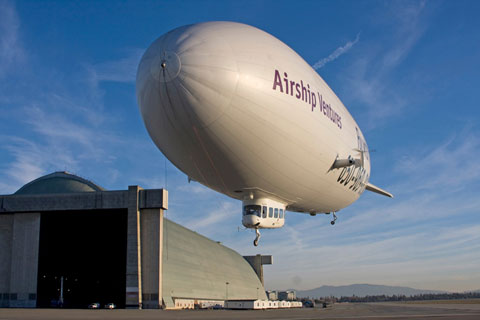
The airship Eureka was pressed into service as a meteorite hunter in Northern California May 3. Photo courtesy of Airship Ventures.
It announced its arrival with thunder and light, crashing to Earth at staggering speed, a messenger from the solar system’s ancient origin. The asteroid, estimated to be more than six feet in diameter when it struck the atmosphere (an estimate based on the loudness of sonic booms reported across Northern California and Nevada) burned brightly enough to be visible in daylight on the morning of April 22.
Shattered into pieces, the remains of an asteroid that likely dates to the origin of the solar system scattered in Northern California. Small pieces were found soon after by meteorite hunter Robert Ward. Astrophysicist Peter Jenniskens, a meteorite specialist who works for NASA, hopes to track down pieces large enough to help shed light on the origins of life on Earth, and is calling on the owners of video security and surveillance cameras to help. A high-resolution image is not required.
“If it’s moving in your video frame, I want to know about it,” said Jenniskens, who called on all owners of video cameras—such as the surveillance cameras used to monitor parking garages, hospitals, or private homes—to email him if any footage was shot at around 7:52 a.m. April 22. A frame-by-frame analysis of such footage could reveal enough information to calculate the speed and trajectory of the object, and help the search team zero in on possible impact sites.
Jenniskens said a search was carried out by air, using a roughly estimated trajectory calculated in part by Doppler radar returns from the day. A small team surveyed a large swath of territory on May 3 in Eureka, the nation’s only commercial passenger airship, operated by Airship Ventures. Using cameras similar to those mounted on television news helicopters, the team of three spotters, two imaging specialists, and a navigator was able to locate and image dozens of possible impact sites. Most were ruled out, Jenniskens said, but about a dozen possible impact sites were identified that merit further investigation on the ground.
The strewn field—the area where the falling pieces fell—is estimated to cover about 300 square miles. Eureka patrolled much of that area, a swath of Central Valley near Folsom Lake around the location where Ward recovered the first pieces, the largest of which weighs about 19 grams, Jenniskens said.
The airship allowed the team to move slowly over the area at 1,000 feet agl, and loiter for hours—a mission that would have annoyed local residents had it been carried out in helicopters. The team was so engaged in the search that any fears of possible airsickness were quickly forgotten, Jenniskens said.
“Everybody loved it,” Jenniskens said, noting the airship’s presence had another purpose: “It showed people that we are interested in trying to find these meteorites.”
Jenniskens, who also works with the nonprofit SETI Institute, said there is much that could be learned about the origin of life if larger pieces can be found before weather breaks them down. While the asteroid was relatively small, it could still provide important clues about how organic compounds—the building blocks of life—came to our planet.
“It could have had some diversity from one spot to the next. It could have been a little world,” Jenniskens said. “The bigger the piece you find, you get context, what materials were found next to each other.”



